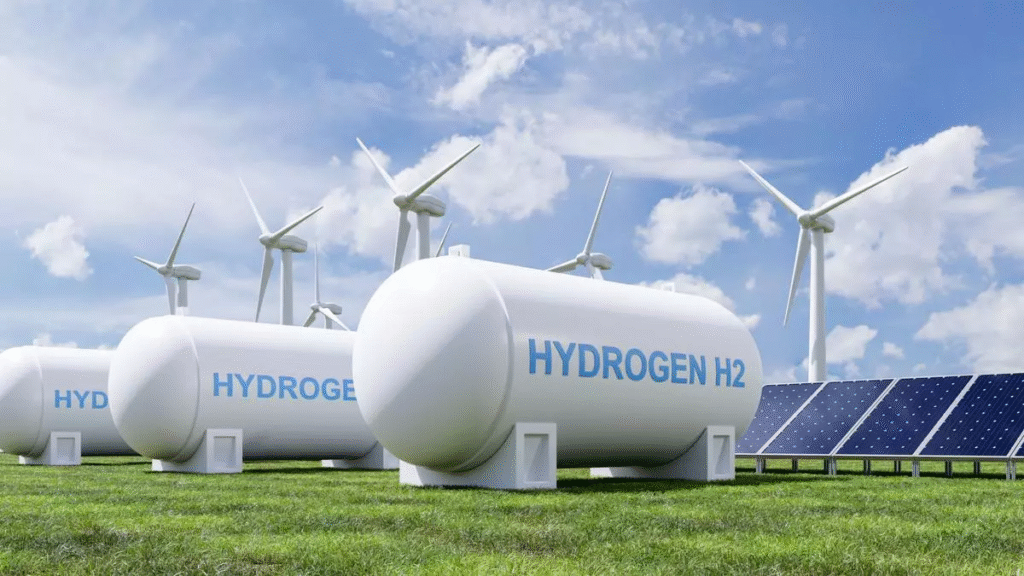
The sun beats down on the vast, arid expanses of Morocco’s Sahara Desert, a landscape that seems endless and unforgiving. But beneath this relentless heat lies a hidden treasure—not oil or gold, but sunlight and wind, resources so abundant they could power a new kind of energy revolution. I first learned about Morocco’s ambitious green hydrogen plans while sipping mint tea in a bustling Marrakech café, overhearing local entrepreneurs animatedly discussing the country’s renewable energy future. Their excitement was infectious, and it sparked my curiosity about how this North African nation is positioning itself as a global leader in green hydrogen, a clean energy source that could redefine how we power our world.
Morocco’s journey into green hydrogen isn’t just a technical endeavor; it’s a story of vision, innovation, and a nation leveraging its natural gifts to tackle global challenges like climate change. In this blog post, we’ll dive deep into why Morocco is betting big on green hydrogen, the investments fueling this transformation, the opportunities and challenges ahead, and what it all means for the global energy landscape. Whether you’re an investor, an environmental enthusiast, or just curious about the future of energy, this is a story you won’t want to miss.
What Is Green Hydrogen, and Why Morocco?
Green hydrogen is produced by splitting water molecules into hydrogen and oxygen using electricity from renewable sources like solar or wind, a process called electrolysis. Unlike “grey” hydrogen, which relies on fossil fuels and emits carbon, green hydrogen is clean, producing only water vapor and heat as byproducts. It’s a versatile energy carrier that can fuel industries, power vehicles, and store renewable energy for when the sun isn’t shining or the wind isn’t blowing.
Morocco’s appeal as a green hydrogen hub is no accident. The country boasts some of the world’s best solar and wind resources. With solar insolation levels of 2,500–3,000 kWh per square meter annually and wind speeds averaging 8–9 m/s along its Atlantic coast, Morocco has the raw materials to produce green electricity at scale. Add to that its proximity to Europe—a key market hungry for clean energy under the EU Green Deal—and you have a recipe for a green hydrogen powerhouse.
But it’s not just geography. Morocco’s government has shown remarkable foresight. Since hosting COP22 in 2016, the country has prioritized renewable energy, aiming for 52% of its energy mix to come from renewables by 2030. The Ouarzazate Solar Power Station, one of the largest concentrated solar plants in the world, is a testament to this commitment. Green hydrogen is the next logical step, building on this renewable foundation to create a new industry that could transform Morocco’s economy.
The Investment Boom: Billions Pouring In
Picture this: one million hectares of public land, roughly the size of Lebanon, set aside for green hydrogen projects. That’s the scale of Morocco’s ambition, announced in March 2024. The first phase allocates 300,000 hectares to investors, both domestic and international, signaling a gold rush of sorts. But what’s driving this investment frenzy?
Major Projects and Players
In March 2025, Morocco approved six green hydrogen projects worth a staggering $32.5 billion, aimed at producing ammonia, green steel, and industrial fuels. These projects, spread across the country’s southern regions, involve global heavyweights like:
- ORNX Consortium: Comprising U.S.-based Ortus, Spain’s Acciona, and Germany’s Nordex, focusing on green ammonia production.
- Taqa-Cepsa Consortium: A UAE-Spain partnership targeting ammonia and industrial fuels.
- Nareva: A Moroccan company with plans for ammonia, fuels, and green steel.
- Acwa Power: A Saudi firm concentrating on green steel.
- TotalEnergies and Partners: Through the Chbika project, TotalEnergies, alongside Copenhagen Infrastructure Partners and A.P. Møller Capital, aims to produce 200,000 tons of green ammonia annually using 1 GW of solar and wind capacity.
These projects aren’t just about energy; they’re about creating value-added products like green ammonia for fertilizers and synthetic fuels for aviation, positioning Morocco as a key supplier in global decarbonization efforts.
Financial Backing
The financial muscle behind these projects is impressive. The European Investment Bank has poured €2.5 billion into Morocco’s renewable sector from 2017 to 2022, with 20% earmarked for green energy. The World Bank and African Development Bank have also chipped in, funding infrastructure like the Ouarzazate plant. Meanwhile, private investments, such as TotalEnergies’ €9.4 billion Chbika project and a $25 billion UAE-Moroccan venture in Dakhla, highlight the private sector’s confidence in Morocco’s potential.
Government Support
Morocco’s government isn’t just opening the door; it’s rolling out the red carpet. The “Morocco Offer,” launched in March 2024, provides a clear framework for investors, including land allocation, tax incentives, and public-private partnerships for shared infrastructure like ports and pipelines. The National Hydrogen Commission, established in 2019, drives this strategy, projecting a demand of 30 TWh by 2030 and 307 TWh by 2050, requiring 2 GW of renewable capacity.
The Economic and Social Promise
Green hydrogen isn’t just about clean energy; it’s about jobs, economic growth, and social impact. Morocco’s phosphate industry, led by OCP Group, is a prime example. OCP, which accounts for 89% of its energy needs through renewables and cogeneration, plans to use green ammonia to decarbonize fertilizer production, a move that could save billions in grey ammonia imports. This shift could create thousands of jobs, particularly in rural areas like Benguerir and Khouribga.
Moreover, green hydrogen projects are expected to stimulate local economies. The Chbika project alone could generate employment in construction, maintenance, and technology development. Morocco is also investing in education, with universities and research institutions like IRESEN offering programs to build expertise in hydrogen technologies.
But it’s not all rosy. I recall a conversation with a local engineer in Rabat who worried about water scarcity—a critical issue given that electrolysis requires significant water inputs. Morocco is addressing this through desalination plants powered by renewables, but sustainable water management remains a challenge in this drought-prone region.
Challenges and Risks: A Balanced View
While the potential is immense, Morocco’s green hydrogen journey faces hurdles. Here are the key challenges:
- Water Scarcity: Electrolysis demands large volumes of water, a scarce resource in Morocco. Desalination is a solution, but it’s energy-intensive and costly.
- Infrastructure Needs: Building pipelines, storage facilities, and export terminals requires massive investment and coordination. The Nigeria-Morocco pipeline is a step in the right direction, but it’s still in development.
- Cost Competitiveness: The levelized cost of hydrogen (LCOH) in Morocco ranges from $3.49 to $5.96 per kilogram, competitive but still higher than grey hydrogen. Scaling up renewables and electrolysis tech is crucial to closing this gap.
- Regulatory Gaps: As noted in a Science article, unclear long-term policies and coordination issues between national and local authorities could deter investors.
- Environmental and Social Impacts: Large-scale projects risk displacing communities or straining local resources. Ensuring equitable benefits is essential.
Despite these challenges, Morocco’s proactive approach—through public-private partnerships, international collaborations like the Germany-Morocco Hydrogen Agreement, and investments in R&D—positions it to overcome these hurdles.
Comparison Table: Morocco vs. Other Green Hydrogen Leaders
| Country | Renewable Potential | Investment ($B) | Key Projects | Export Focus | Challenges |
|---|---|---|---|---|---|
| Morocco | High solar/wind | 32.5 | Chbika, ORNX | EU, ammonia | Water scarcity, infrastructure |
| Australia | High solar/wind | 50+ | HyResource | Asia, domestic | High costs, distance to markets |
| Saudi Arabia | High solar | 110 (NEOM) | NEOM Green | Global | Water scarcity, governance |
| Chile | High wind/solar | 10+ | Haru Oni | EU, Americas | Infrastructure, remoteness |
Table: Comparing Green Hydrogen Leaders
This table highlights Morocco’s competitive edge in renewable potential and proximity to Europe, though water scarcity and infrastructure remain universal challenges.
The Global Context: Why Morocco Matters
Morocco’s green hydrogen push isn’t happening in isolation. The EU’s Green Deal aims to import 10 million tons of renewable hydrogen by 2030, and Morocco’s proximity makes it a prime supplier. Agreements with Germany and Portugal for hydrogen exports underscore this role. Globally, the green hydrogen market is projected to reach $1.4 trillion by 2050, with Morocco potentially capturing 4% of global demand by 2030, according to the World Energy Council.
I spoke with a German energy consultant who described Morocco as “Europe’s solar and wind backyard.” This isn’t hyperbole—Morocco’s strategic location and existing energy interconnections, like the Morocco-Spain power link, make it a natural partner for Europe’s decarbonization goals.
Actionable Advice for Investors and Stakeholders
For those looking to get involved, here’s how to navigate Morocco’s green hydrogen boom:
- Investors: Focus on integrated projects (renewables + electrolysis + derivatives like ammonia). Engage with the Morocco Offer for land and incentives. Partner with local firms like Nareva to leverage local expertise.
- Policymakers: Prioritize clear, long-term regulations and water management strategies. Strengthen public-private partnerships to share infrastructure costs.
- Communities: Advocate for inclusive projects that prioritize local job creation and environmental safeguards. Engage with initiatives like the Green Hydrogen Cluster to ensure community voices are heard.
- Researchers: Invest in R&D for cost-effective electrolysis and storage solutions. Collaborate with institutions like IRESEN to drive innovation.
FAQ: Your Questions About Green Hydrogen in Morocco Answered
Q: What makes Morocco ideal for green hydrogen production?
A: Morocco’s abundant solar and wind resources, proximity to Europe, and supportive government policies make it a prime location. Its renewable energy infrastructure, like the Ouarzazate Solar Power Station, provides a strong foundation.
Q: How much is Morocco investing in green hydrogen?
A: Over $32.5 billion across six major projects, with additional investments like TotalEnergies’ €9.4 billion Chbika project and a $25 billion UAE-Moroccan venture.
Q: What are the main challenges?
A: Water scarcity, high initial costs, infrastructure development, and regulatory gaps are key hurdles. Desalination and international partnerships are helping address these.
Q: How will green hydrogen benefit Morocco’s economy?
A: It’s expected to create jobs, reduce import dependency (e.g., for ammonia), and position Morocco as a global energy exporter, potentially capturing 4% of global demand by 2030.
Q: Is green hydrogen environmentally friendly?
A: Yes, when produced with renewables, it emits no carbon. However, water use and land allocation must be managed sustainably to avoid environmental harm.
Q: How can I invest in Morocco’s green hydrogen sector?
A: Explore opportunities through the Morocco Offer, partner with local firms, or engage with financial institutions like the European Investment Bank. Consult with Morocco’s Investment Charter for incentives.
Conclusion: Morocco’s Moment to Shine
As I reflect on my time in Morocco, from the vibrant souks of Marrakech to the windswept coasts of Dakhla, I’m struck by the nation’s audacity. Green hydrogen isn’t just a buzzword here; it’s a vision to transform a sun-soaked, wind-rich country into a global energy leader. With $32.5 billion in projects, partnerships with global giants, and a government committed to sustainability, Morocco is writing a new chapter in its history—one that could inspire other nations to follow suit.
But the road ahead isn’t without bumps. Water scarcity, infrastructure costs, and the need for clear policies demand careful navigation. For investors, the opportunity is clear: a chance to back a burgeoning industry with global impact. For Moroccans, it’s about jobs, innovation, and a cleaner future. And for the world, Morocco’s green hydrogen revolution offers a blueprint for balancing economic growth with environmental stewardship.
If you’re intrigued, take the next step. Research Morocco’s Investment Charter, connect with local stakeholders, or dive into the science of green hydrogen. The desert sun is shining, the winds are blowing, and Morocco is ready to lead. Will you be part of this story?
